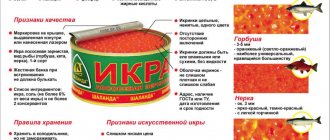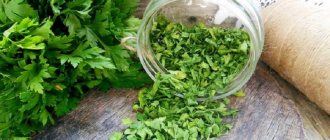Preparing caviar
Salting red caviar begins with its preparation. Ideally, you need to remove caviar from fish within 30-45 minutes after it is caught. If this is done with a delay, the film to which the caviar is attached will lose strength and may burst earlier than necessary.
Pink salmon with caviar
According to GOST, red caviar must be salted no later than 6 hours after it is caught.
Unfortunately, this is only possible if you caught the fish yourself or on fishing vessels. In other cases, you will have to work with what you have.
On the mainland, you can “get” fresh caviar by buying a whole fish carcass. It is best if it is a female pink salmon or chum salmon. Females and males of salmon differ in color. Choose lighter colored fish with a round head shape.
It is recommended to take fresh fish, but under the guise of fresh, they often sell defrosted fish. Therefore, it is difficult to recommend anything here.
If you have frozen fish, you need to defrost it correctly: place it in the refrigerator for 4-6 hours, and only then defrost it at room temperature.
Rapid defrosting is not allowed, as the caviar will begin to leak and become unsuitable for salting.
After the fish is completely defrosted, it must be very carefully ripped open and removed without damaging the film in which the caviar is located.
If the oyster is still damaged, all further actions with the eggs are carried out only in salt water. Contact of caviar with fresh water is not allowed.
Salting caviar is somewhat more difficult than salting fish, but easier than making balyk from fish.
Salting caviar for storage
The total salting time in cooled brine is 15 minutes. The caviar is salted in two stages of 7.5 minutes each.
In order not to miss the time, it is better to use a timer.
To begin with, you should measure the required amount of brine, remembering that its total volume should be three times the volume of caviar. That is, one kilogram of caviar will require three liters of brine.
The washed, punched caviar is drained into a colander and when the excess water has drained, we begin salting:
- The caviar is placed in an enamel container and filled with half the volume of measured brine and the time is noted. All seven and a half minutes, the caviar filled with brine must be carefully stirred with a wooden spoon.
- After 7.5 minutes, the caviar with the spent brine is dumped into a colander and everything is repeated: the caviar is poured with clean brine and stirred for another seven and a half minutes, after which it is sent to drain.
If, after salting, foreign particles remain in the caviar, it can be “rolled” on a piece of gauze. The caviar is placed in gauze like a hammock and sways from side to side. All excess remains on the gauze.
Stitching and packaging
The caviar is placed in a strainer or gauze bag and suspended over a container into which excess liquid will drain. The time allocated for this is 24 hours and cannot be reduced.
After draining, the caviar is packaged in glass jars washed with fresh brine and stored in the refrigerator.
Another important rule:
Your hands, tools, utensils - everything that comes into contact with caviar should be washed with brine. If this is not done, the caviar will begin to deteriorate very quickly.
How to salt red caviar: “wet” recipe
Ingredients:
- Red caviar – 150 g.
- Water - 1 l.
- Salt - 5 tbsp.
- Sugar - 1 tbsp.
Preparation:
- First you need to prepare a strong saline solution.
- Pour 1 liter of water into a saucepan.
- Add salt and sugar, put on fire. The water needs to be boiling.
- When all the salt has dissolved, cool the solution to 50 degrees.
- The caviar is contained in a film called yastek. To release the calf, you can use the methods described here. Alternatively, place the bags in the saline solution and start stirring with a fork. Simple movements, like beating eggs.
With this method, we kill two birds with one stone - we remove the film and begin the salting process. The optimal time for caviar to remain in the salt solution is 15 minutes.
- After cleaning the caviar and waiting time, pour the brine through a colander or strainer.
Caviar salted in this quick way can stay in the refrigerator in a glass container for no more than 2 - 3 days.
Dry trout
Caviar from trout and char is the most delicious of all those obtained from salmon. Light yellow, amber colored eggs look great on sandwiches or in canapés mixed with finely chopped green onions and butter.
- trout caviar – 200 g;
- salt – 1 tbsp. spoon;
- sugar - a pinch.
Note: A “pinch” is something that fits between your thumb and index finger without strain.
- Punch the calf.
- Rinse with salted water (1 tablespoon of salt per 0.5 liter), drain on a sieve and place in glass, enamel or ceramic dishes.
- Mix with salt with a wooden spatula until foam forms.
- Add sugar.
- Stir occasionally for 15-20 minutes.
- Place in a sterilized glass jar and refrigerate.
- Eating is possible after 12 hours.
Salting red caviar: a classic recipe
This is a dry technology that does not involve the participation of water. Red caviar - dry salting at home.
Ingredients needed:
- red caviar - 500 g;
- salt - 3 level tablespoons.
Recipe (steps step by step)
Step 1. Gut the fish, remove and wash the fish, remove the film.
Step 2. Place a layer of salt (quite dense) on the bottom of the pan, add an even layer of eggs, and sprinkle a little on top as well. Several more layers are created in exactly the same way.
Step 3. Place the product in the refrigerator, and after 3-4 hours lightly salted red caviar is ready. A medium-salinity product will be ready in 10-12 hours (just put the caviar in the refrigerator overnight).
How to salt red caviar: dry salting
This method of salting will allow you to store caviar in the refrigerator for up to 2 weeks.
Ingredients:
- Red caviar - 1 kg.
- Coarse salt - 2 tbsp.
- Vegetable oil - 2 tbsp. spoons
Preparation:
- The process begins with releasing the eggs from the cage (if this has not been done in advance). To do this, place the caviar in a colander. Place it in boiling salt water and soak for 25 - 30 seconds.
- Then pass the caviar through a large mesh sieve.
- Then place in an enamel bowl and gradually add salt, while stirring with your hands or a wooden spatula.
- When finished, distribute the caviar into pre-sterilized glass jars.
- Add vegetable oil on top and close the lid.
Dry trout
Caviar from trout and char is the most delicious of all those obtained from salmon. Light yellow, amber colored eggs look great on sandwiches or in canapés mixed with finely chopped green onions and butter.
- trout caviar – 200 g;
- salt – 1 tbsp. spoon;
- sugar - a pinch.
Note: A “pinch” is something that fits between your thumb and index finger without strain.
- Punch the calf.
- Rinse with salted water (1 tablespoon of salt per 0.5 liter), drain on a sieve and place in glass, enamel or ceramic dishes.
- Mix with salt with a wooden spatula until foam forms.
- Add sugar.
- Stir occasionally for 15-20 minutes.
- Place in a sterilized glass jar and refrigerate.
- Eating is possible after 12 hours.
How to salt red fish caviar according to GOST
Red caviar, salted according to GOST, has the highest quality and the most pleasant taste. At home, it is quite difficult to pickle a product in this way if you follow all the rules. Still, it's worth a try.
- Ideally, in accordance with GOST, red fish caviar should be salted for 6 hours. after the fish has been caught.
- The second requirement is for brine - a solution for salting a valuable product. It should be prepared exclusively from boiled water cooled to 10°C and salt.
- The third requirement concerns the packaging of ready-made caviar, but in principle it does not concern us, since caviar prepared at home is rarely stored for more than a few weeks.
Caviar
So, prepare the following products:
- Red fish caviar – 1 kg
- Water – 2 l
- Salt
- Refined vegetable oil – for storage
- Fresh egg to determine water salinity
Recipe:
- We take the caviar from the previously defrosted fish. If you bought frozen caviar separately, defrost it this way - within 5 hours. in the refrigerator, and then until completely defrosted at room temperature
- Rinse the eggs in cold water.
- Clean the caviar from films using one of the methods described above. If you are salting a product for the first time, give preference to the option with a mixer.
- Boil the specified amount of water, and then start adding salt to it. You will need quite a lot of salt. In order not to miscalculate its quantity, place a fresh egg in a container of water. When the liquid is salty enough, the egg will float.
- Leave this solution to cool. If you want to follow all the rules, let the solution cool to 10°C.
- Pour the resulting solution over the caviar, cleared of ostriches, and leave it for 10-20 minutes.
According to GOST
- To check if the product is ready, take a few eggs and crush them with your fingers. If the liquid splashes, it means that the caviar has not yet been salted enough, but if it flows like an oil solution, it means that the product has been salted.
- Place the salted caviar on cheesecloth, hang the gauze over a basin and let the liquid drain. This process will take no more than a few hours.
- Prepare containers for storing the delicacy - sterilize glass containers, rinse plastic containers in a solution of water and salt.
- Place the product in containers, season it with a little oil and store it in a cool place.
- This product is not recommended to be stored for too long. It is best to eat caviar within a few weeks.
Preparation
Once the fish has been selected, you can begin gutting it. Before cutting up a chum salmon carcass, it must be properly defrosted. To do this, place it on the bottom shelf of the refrigerator and wait until it thaws completely. Then the belly is carefully cut, trying not to damage the ovaries, and the caviar is removed. The ovary is a bag made of a dense and elastic film, inside of which there are eggs. One medium-sized carcass contains approximately 100 g of red chum caviar. After the oyster is removed, it is thoroughly washed under running cold water.
The next stage of preparation for salting will be freeing the eggs from the film. The procedure is quite simple and can be done in several ways. The yashtik can be rubbed through a coarse sieve or an old tennis racket, passed through a gauze sleeve or used in a mixer. The last option is the least labor-intensive and allows you to quickly clean the eggs from the films.
To do this, pour cold water into a deep container, add a little salt and drop the bags into it. Then place a mixer in the water (it is advisable to use spiral attachments) and turn it on. If you don't have a mixer, you can use a whisk or fork. This procedure will require a little more time, but will also allow you to effectively clean the eggs from the film using available means.
How to pickle red caviar at home, tasty and quick
A homemade delicacy can be no worse than store-bought. Therefore, it is important to buy a fresh product and follow the cooking technology. It is better to choose fish from the salmon order with red meat.
Since most stores sell fish frozen, the question arises: is it possible to salt caviar from frozen pink salmon? It is possible, but the carcass must be carefully defrosted first.
Ingredients:
- pink salmon caviar – 400 – 500 grams;
- purified water – 1 liter;
- white sugar – 1.5 dessert spoons;
- rock salt - exactly 5 teaspoons;
- seasoning for fish - optional.
Steps:
- The first step is to defrost the fish carcass naturally. First place the fish in the refrigerator, then defrost it in the kitchen at normal temperature. Carefully cut the belly with a knife, starting from the lower rear fin. Get the main ingredient.
- Now it is important to separate the eggs from the films. You can do this with your hands by tearing the bag. Place them in warm, clean water to quickly separate the excess from the eggs. Slowly stir in a circle with a wooden skewer. The film comes off well. Strain the contents through a sieve and dry on a cloth towel.
- How to pickle red caviar from pink salmon at home? Next, cook the brine, it is also called brine. Boil the specified amount of liquid, stir in a portion of table salt and sugar. The salty brine prevents the eggs from sticking to each other. Cool the liquid and pour the resulting brine into the container with the caviar for half an hour.
- The last step is to strain the eggs through a fine sieve or cheesecloth. Then place them in a dry glass jar. Now, wondering whether it is possible to salt caviar from frozen pink salmon, it is not difficult to repeat this recipe. However, the shelf life of the delicacy on the refrigerator shelf should not exceed 4 days.
Stage Three: Ambassador
In brine
Brine is a concentrated salt solution that is prepared both for salting caviar and fish meat. The technology for its preparation is simple: dissolve 2 tablespoons of coarse table salt and 1 large spoon of sugar in a glass of cool water. You can check the quality of the brine using a raw egg or a small peeled potato. With sufficient salt concentration, these products will float.
The caviar is placed in the curing solution for 7-9 minutes. In this case, the caviar will turn out lightly salted. If you keep the eggs in brine for 15 minutes, the degree of salting will be maximum.
The caviar is dried on a gauze cloth and then transferred to a small container, adding ½ teaspoon of vegetable oil.
Elena Puzanova in her video offers her recipe for salting pink salmon caviar
Dry salting
The delicacy is transferred to a jar, the walls of which are greased with vegetable or olive oil. To make the caviar crumbly, oil (no more than ½ teaspoon) is added to the caviar itself.
The option of salting with food-grade potassium nitrate to preserve the rich color of the eggs is described in detail in our article.
“Lightly salted” with vegetable oil
For the same 500 grams you will need:
- 15 grams of salt and sugar;
- 25 grams of refined, odorless oil (this is important!).
How to properly salt with butter? In a glass jar, mix the oil and bulk ingredients, stir to dissolve.
Then add the washed caviar and mix very carefully so that the eggs are not damaged. You can close the lid and gently swirl the jar to distribute the ingredients evenly. If you like a saltier snack, add more salt.
How long will it take? Place the jar in the refrigerator for 8–10 hours, after which the product will be ready for use. You can store it longer - on average for 10-14 days.
Storage conditions
To ensure that the delicacy does not lose its taste and that the eggs are soft and not overdried, it is important to store it in glass jars.
They are pre-steamed. Next, you need to take a sheet of clean paper, soak it in oil and place it on the neck of the jar. It is placed in the refrigerator or in a cold place.
The optimal temperature at which the taste of the grains is preserved is 5C.
The container must be sealed tightly so that the eggs do not come into contact with oxygen. If the conditions are met, the product can be stored for about 10 months.
When the packaging loses its integrity or the temperature changes, the shelf life is significantly reduced and the product needs to be consumed faster.
Important! If there is a small amount of caviar left in the jar, and you want to keep it fresh, then scald it with boiling water, and put a couple of slices of fresh lemon on top.
The product will remain fresh for 7-10 days. Before use, it is recommended to add a few drops of olive or vegetable oil. The grains become shiny and taste improves.
Five-minute caviar. Recipe
Five-minute caviar is made from fresh fish roe and is rightfully considered one of the most delicious dishes. In addition, it retains all natural properties, which is why it is very useful.
To prepare the “five-minute” you will need:
- Red caviar
- 1 liter of water
- 6 tablespoons of salt (heaped).
Perhaps it’s worth starting with the fact that you need to get the most important ingredient - caviar. To do this, you need to rip open the belly of the “female” and remove the eggs into a bowl. Then, using a net, you need to break through the eggs. The net should be such that the eggs can easily pass through it and be cleared of excess mucus.
You can also clean the caviar using a knife. Having placed it on a cutting board with the eggs down, you need to push them out of the chaff with the back of the blade. It is better to start this action from the edge so as not to crush the eggs.
The next step is preparing the brine. Fishermen know the meaning of this word very well. For those who have not “hunted” fish, let us explain that this is just a solution for salting fish and caviar. To make this solution, you need to boil water, pouring salt into it so that it completely dissolves. It is better to remove the remaining undissolved salt. The brine needs to be cooled to room temperature.
Place caviar in the resulting solution and leave it for 5 minutes. Next, use gauze to strain the resulting dish. To get as much water out as possible, it is better to carefully roll the caviar on gauze.
The resulting caviar can be safely served. Some people like to spread it on black bread, some prefer to wrap it in a pancake, and others can simply eat it with tablespoons.
You can store this caviar in the refrigerator for no more than 3 days. However, as fishermen say, “five-minute” is not because it cooks quickly, but because it is eaten in 5 minutes.
Cleaning eggs from caviar
The caviar is in two film bags (bags) - you need to get rid of them.
The work is painstaking, but necessary. This must be done extremely carefully so as not to damage the caviar itself. (Unless there is another goal).
Using your hands, carefully separate the caviar from the film.
Next, place the caviar in a bowl and fill with cold water.
Using a wooden stick, we begin to mix intensively in one direction. Periodically we take the stick out of the water and remove the remaining film, which wraps very well around a wooden skewer. In this way, we will sufficiently clean the red caviar from the film.
Now line the colander with gauze, folded in half, and place the caviar on it. And let the liquid drain. Next, we will move the caviar in a colander over dry gauze. Small particles of film and crushed eggs will stick to the fabric.
Red caviar - five minutes
Ingredients
- Red caviar
- Salt
When cutting fresh red fish (trout, salmon, chum salmon, sockeye salmon, pink salmon and others), red caviar is sometimes found; it can be prepared at home or on the go in just a few minutes using the following recipe.
01. Trout with caviar
First of all, two eggs with caviar must be removed from the fish. Red fish contains a lot of caviar - up to 30% of the weight of the fish. In the example, fresh trout weighing about 2 kilograms contained 250 grams of caviar.
02. Two eggs with caviar
When the eggs are removed, the eggs should be torn apart, removing the films as much as possible, but you should not try too hard - there is a risk of bursting the eggs. It will be much easier to remove the films later. In the meantime, the main thing is to loosen the caviar a little so that it does not lie in too big a lump, otherwise it will be salted unevenly.
03. We tear apart the yasytki
The eggs must be thoroughly washed in cool running water to remove any remaining blood, mucus and the contents of burst eggs. A fine-hole colander or sieve is suitable for rinsing.
04. Wash the caviar
The washed caviar should be generously salted at the rate of one heaped tablespoon of salt for every 100 grams of caviar. It will not work to over-salt as the caviar will not take up the excess salt. After pouring out the salt, mix it with the caviar and leave to infuse for 5 minutes. Due to the fact that the caviar is salted for 5 minutes, the recipe is called “five-minute”.
05. Salting caviar
After 5 minutes of salting, the caviar should be poured with boiling water. It is worth paying attention that it is better to put the kettle on in advance, as it can boil for more than 5 minutes.
06. Pour boiling water
Then the water must be drained through the same colander or sieve. After heat treatment, the films from the caviar are much easier to remove, but it is still quite painstaking and tedious work that takes up most of the time for preparing red caviar.
07. Drain the salt water
Ready red caviar should be stored in the refrigerator. It is best to make classic sandwiches from caviar on fresh white bread with butter.
Tips for preparing red caviar:
- It is most convenient to remove caviar if the fish is not completely defrosted.
- If you don’t have a drain, then the caviar in the solution can be transferred to cheesecloth and, carefully rolling the delicacy, ensure that the liquid drains completely. You will need help in this matter, since holding the gauze on both sides at the same time and rolling the caviar alone is problematic.
- It is recommended to keep the caviar in the solution for 10 minutes. The time depends on your preferences. The saltier you like your caviar, the longer you keep it in the solution. And remember that lightly salted caviar cannot be stored for long periods of time.
- In the refrigerator, you need to store caviar in tight glass jars with a lid. The delicacy is also suitable for freezing. If you do not defrost it, the shelf life reaches 6-8 months.
Now you know how to pickle caviar at home. To prepare the delicacy, you can use fresh caviar if you live in the fishing area, or buy frozen, ungutted fish. The second option is more complicated, but allows you to save money and, in addition, get delicious salmon, which makes excellent main courses and snacks. Fish meat can also be salted in brine, resulting in several pieces of the delicacy.
Five minutes
How to salt caviar using the “five-minute” method?
Five-minute caviar is called caviar, the total salting time of which is five minutes - two stages of 2.5 minutes each. Everything else is done the same as in the previous recipe.
The drain time remains the same - 24 hours. If this time is reduced, then the caviar will not have time to “ripen”.
This caviar is less salty and can be stored in the refrigerator for no more than 10 days. Five minutes is best consumed immediately after preparation.
Five minutes of navaga caviar turns out very tasty. Grayling caviar is also salted in this way.
PS This method of salting red caviar is used by enterprises engaged in wholesale supplies of the product to the domestic and foreign markets.
Antiseptics and preservatives, which are needed for long-term storage, were excluded from the recipe. When caviar is made for oneself and not for sale, they are not added.
There are many recipes in which the authors suggest dipping red caviar in boiling water and doing other equally strange things. But caviar is a very delicate and capricious product. It's very easy to ruin it. If you want to get the right taste, follow the above mentioned salting method.











